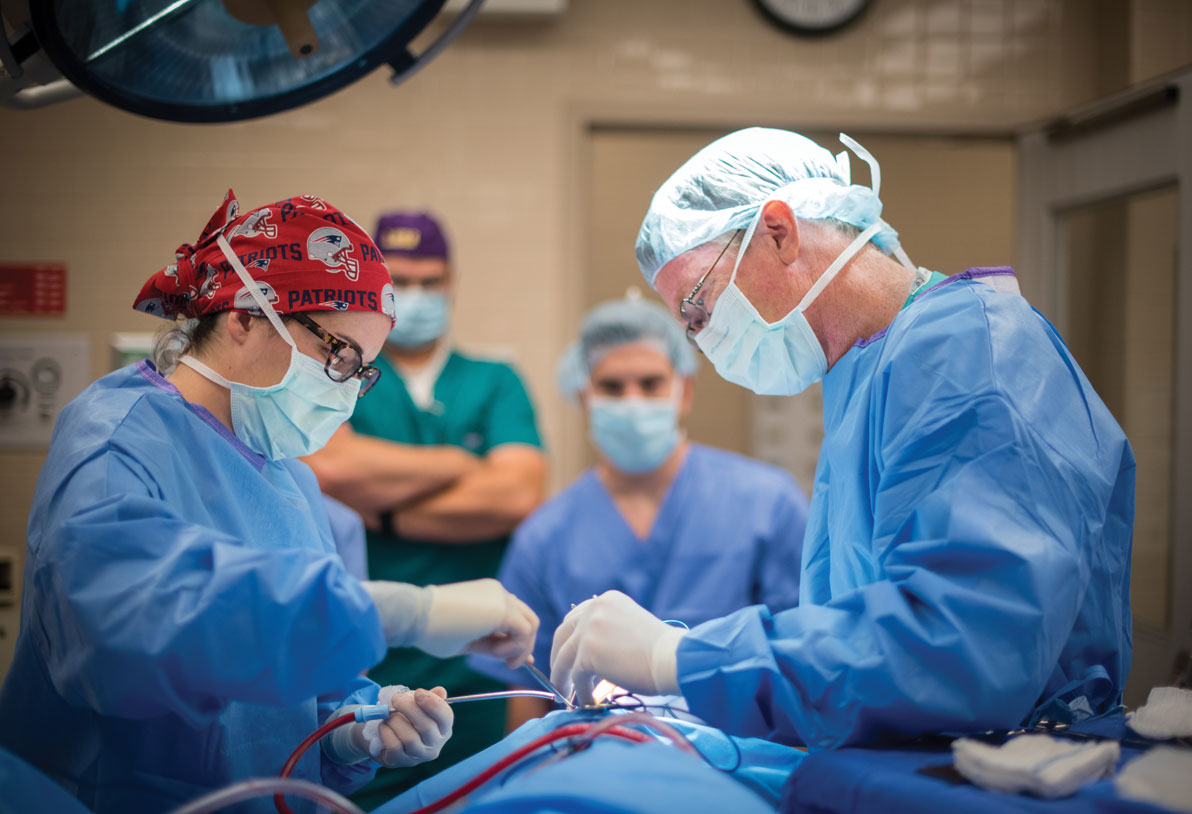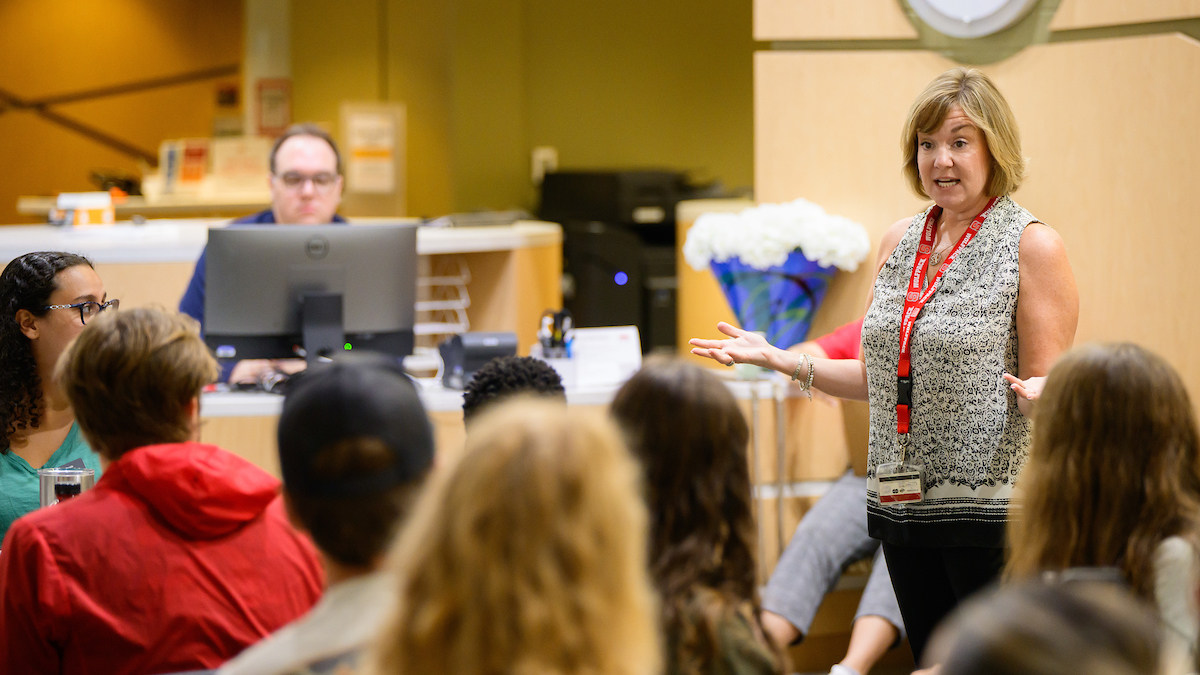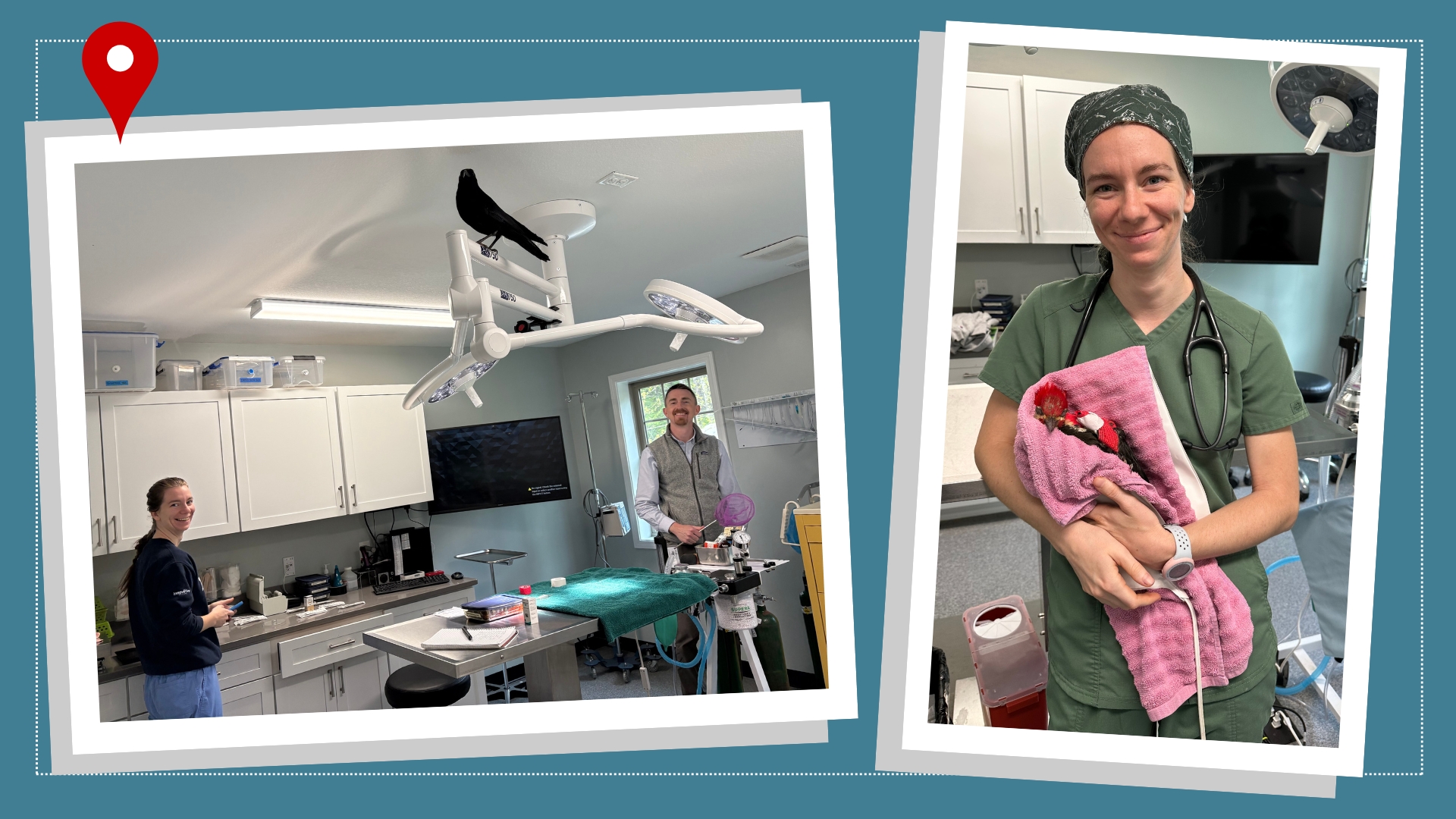Veterinary Medicine’s Masked Heroes

It’s a little after 9 a.m. on a Friday, and the soft tissue and oncologic surgery service rounds room is quiet.
It’s not usually like this, but scribblings on the office space’s glass wall reveal why. There’s a list of surgeries, about six or seven deep, written with green erasable marker. The names of lead surgeons are assigned on top of each. You can just barely make out the word “chimp.”
At the end of the day, these will be erased. Soon, there will be a new list, likely just as long.
Montana DiVita, a fourth-year NC State College of Veterinary Medicine student, is waiting in the office space in the Veterinary Hospital. She doesn’t want to be sitting here. She’s eager to head down the hall, don shoes and hair cover and a mask to complement her scrubs and white coat, and walk into an operating room or two.
The OR is where DiVita and her fellow soft tissue rotation students most want to be — and are most wanted. In operating room 5, Kyle Mathews, professor of soft tissue and oncologic surgery, is working on Danny Boy, a 5-year-old golden retriever. Mathews is focused on one of the dog’s leg sticking out from under a sheet. He’s fixing an arteriovenous (AV) fistula, an abnormal connection between an artery and a vein. He is joined, as usual, by a resident, an intern and many fourth-year students.
About 20 feet away in operating room 8, the day’s other lead surgeon, Valery Scharf, clinical assistant professor of soft tissue and oncologic surgery, is tackling another case: Moose, a 7-year-old Labrador retriever.
Moose requires a partial mandibulectomy to remove the large tumor in his jaw before it spreads.
Over a few hours, half of Moose’s lower jaw will be removed by Scharf. She, too, is joined by a resident and an intern. As Scharf works, between the loud whizzes of a surgical drill and a bone saw, she talks them through the surgery step by step as they assist.
The fourth-year students walk back and forth between OR 5 and OR 8, often observing quietly and shuffling around the rooms to find the best angles to watch. Some ask questions. Some find it better to watch silently.
[pullquote color=”blue”]It’s all amazing to watch — sometimes tense, often powerful solely for the mastery of a delicate scalpel movement. [/pullquote]
Sometimes the surgeries are so intense and complicated, silence is the only reasonable reaction.
“This,” says Scharf as she works on Moose, “has the potential to cure this dog.”
It’s all amazing to watch — sometimes tense, often powerful solely for the mastery of a delicate scalpel movement.
For Scharf, who later will suture a pacemaker on the beating heart of a 10-year-old Staffordshire bull terrier, this is a typical day: multiple serious surgeries, nerves, teaching, blood and ultimately the gratification of saving the life of someone’s pet.
It’s the typical day-to-day experience for everyone on the service’s team as well.
Led by four surgeons — Mathews, Scharf, Christopher Adin and Marije Risselada — the soft tissue and oncologic surgery service sees small animal patients with a wide variety of conditions. Many of its cases, about 60 percent or so, according to Mathews, involve cancer surgery. Scharf said the service sees at least one case a day that involves some form of cancer.
But during the week, the group can also tackle cases involving respiratory conditions, reconstructive and plastic surgery, head and neck issues and gastrointestinal diseases.
[pullquote color=”blue”]“If we have a day where we have surgery after surgery and they’re intense but they go well, your students are enthusiastic, your residents are learning and your clients are happy — that’s the kind of day that’s so fulfilling,” says Scharf[/pullquote]
The service often works hand-in-hand with other Veterinary Hospital specialists, including those in critical care and internal medicine. Cancer treatments require detailed and individualized plans, usually involving chemotherapy or radiation or both. Many cases require 24-hour postoperative monitoring. These require coordination with the medical oncology and radiation oncology services.
“We get oncologic cases, acute cases and everything in between,” says Mathews. “And then we see emergencies in the middle of the night that aren’t going to make it until the morning unless we step in.”
On this day, after Mathews finishes with the AV fistula surgery, he’ll perform abdominal exploratory surgery on a visiting chimpanzee. After that, he’ll surgically remove fungus from a dog’s nasal cavity. He successfully performed a similar fungal surgery the day before.
And while the prognosis for Moose, Scharf’s first patient of the day, is good once the tumor is removed — months later, he is still doing well, she says — the other day Mathews had a case where there was little they could do to rid a dog of a particularly large and invasive facial tumor.
For the team, the cases are frequent and the hours are long. The surgeries are often challenging and stress-inducing and rewarding. But even during 2 a.m. emergency calls, the team’s surgeons enjoy the adrenaline rush.
“If we have a day where we have surgery after surgery and they’re intense but they go well, your students are enthusiastic, your residents are learning and your clients are happy — that’s the kind of day that’s so fulfilling,” says Scharf. “And there are so many of those.”
At any given time, the team of about 10 fits into the rounds room, a shared work space near the operating rooms. Along with the surgeons, the soft tissue and oncologic surgery service team usually includes one surgical intern and four-to-five fourth-year CVM students, here for a few weeks as part of a clinical rotation in the hospital. The service has a total of five residents, though just one surgery resident is with the service at a time. The service has one clinical technician and is looking for a second.

In between surgeries, the group sits in this room to pour over research and perform consultations for other services and also for referring vets. At the end of each day, the team tries to meet to go over the day’s experiences. That’s part of the learning experience, especially for fourth-year students.
When the team returns from this morning’s surgeries, they are drawn immediately to their chairs and their open laptops spread across a central table.
Breaks like this one don’t last too long. The big surgery of the day is a procedure would normally be one of the least remarkable — the exploratory abdominal surgery. But when that’s being performed on a chimpanzee, lunch is put on the backburner in order to watch.
The chimp was transported to the CVM by the North Carolina Zoo and Mathews is the lead surgeon on this one as well. This is the kind of day where if you want to see Mathews, you’ll have to see him in an operating room.
“For me personally it’s challenging and that’s what I like,” says Mathews, who arrived at the Veterinary Hospital in 1997 following four years as a clinical instructor at the University of California-Davis. “There’s a lot of different things you get to work on. You never get bored. And, importantly, you never stop learning at a facility like this where you are surrounded by experts in every veterinary speciality.”
The oncological cases are memorable and complicated. But they are the types of cases that are often the most rewarding for Mathews. To be a surgeon is to be given the opportunity to cure and that is a powerful motivator.
As Scharf puts it, soft tissue and oncologic surgeons often get the chance to be heroes in the eyes of pet owners. At 34, she is the youngest surgeon on the team, joining the Veterinary Hospital in the summer of 2014. In veterinary school at Texas A&M University, she initially pursued an interest in large animals; she liked cows and loved being outdoors. But she also loved anatomy and dissection; surgery was always high on her interest list and she received encouraging feedback from clinical residents and instructors.
[pullquote color=”blue”]“You have a dog that comes in and is bleeding and on death’s door and you’re able to give the owners the good news — that we fixed it and your pet is going to be OK,” says Scharf. [/pullquote]
By her fourth year in veterinary school, she knew soft tissue and oncologic surgery were for her.
“You have a dog that comes in and is bleeding and on death’s door and you’re able to give the owners the good news — that we fixed it and your pet is going to be OK,” says Scharf.
Scharf, who considers Mathews a mentor, actively sought positions in academia because she enjoyed teaching. That’s a big part of the surgeons’ jobs as well.
The fundamental lesson for residents and interns is getting a strong grasp on procedure. But they gain much more than technical expertise.
“I really want them to look at the whole patient and that means understanding the diagnostics leading up the surgery,” says Scharf. “But it’s also showing that it’s their responsibility in terms of patient care to follow up. That’s a huge part of it. It’s one thing to do the procedure in the OR, but if you also can’t take care of your patient outside of the OR you’re not going to be a good surgeon.”
Additionally, many of the service’s patients recover in the intensive care unit. An understanding of critical care medicine and the ability to coordinate care with the experts on the hospital’s critical care service are essential.
For DiVita and her fellow fourth-years, the surgeries make a strong impact — and the students are frequently active participants to various degrees. It’s vital to watch complicated cases and be a part of them. It’s vital to revel in a successful cases and feel the emotional crush when nothing can be done.
Fourth-year students have a limited role in surgeries, especially the most critical cases, but there’s always something to retract or suture or flush out with saline. During their rotation, Scharf aims to guide fourth-years’ understanding of diseases that require surgery, mastering how to find out what they need to know about their patients and thoroughly knowing the available treatment options. The soft tissue surgeons want fourth-years on rotation to walk away from their time with a service knowing the best ways to talk to their clients in the real world after they graduate.
And the rotation with the soft tissue and oncological service helps hone patient communication skills as well. During the visit Friday, DiVita received a call from a owner asking for an update on a pet.
“Of course that part is difficult, we have cancer cases,” she says. “It’s tough and always will be. But for me, I think about how I would want my own pet’s condition explained to me.”
After the short break in the rounds room, DiVita makes her way again to an operating room. Scharf is here with Jezzabelle, the 10-year-old Staffordshire bull terrier who needs to have her spleen removed and a pacemaker put in.
At the same time the pacemaker is successfully implanted, Mathews oversees the nasal operation in another room. That involves using a polymer-based substance made specially at the hospital’s pharmacy that gels after injection into dog’s nasal cavity.
Once again, the chairs in the service’s rounds room are empty. The laptops are open but silent. The operating rooms are full.
And it’s not yet 2 p.m.
For more information on the NC State Veterinary Hospital’s soft tissue and oncologic surgery service, go to cvm.ncsu.edu/nc-state-vet-hospital/small-animal/soft-tissue-surgery.
~Jordan Bartel/NC State Veterinary Medicine
- Categories:


